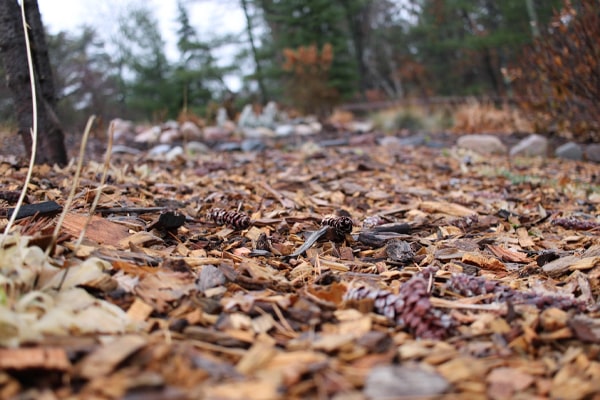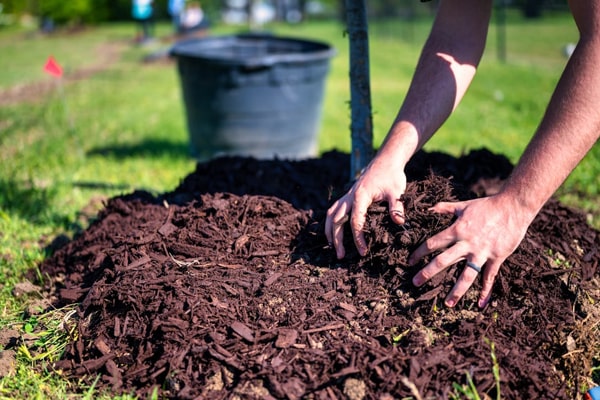If you are serious about gardening then you know that mulching is an integral part of a well-maintained garden. Contrary to popular notion, mulching is not done simply to enhance the look of a garden. Mulching has its practical uses too. In this guide, let us talk about the importance of mulching, types of mulching to consider, how to mulch, and the other important factors that come to play when it comes to mulching:
Contents []
What is Mulching?

Mulching is the term used to describe the addition of a protective layer around plants to improve a garden's health and appearance. Mulching materials are spread over garden beds and surrounding greeneries to support proper growth and reduce the effects of harsh weather conditions.
Apart from creating a protective barrier against harsh weather conditions, mulching also improves the soil’s structure. It keeps pests at bay while letting garden-friendly critters thrive. In addition, mulching protects the plant roots from weeds, frosts, and intense heat. The mulch could also improve the soil texture, which is beneficial for gardens that get a lot of snow. Using the right mulching material keeps the soil moist and nutrient-rich, eliminating the need for fertilizer. All of these contribute to a healthy-looking garden that you’d be proud to show off!
Types of Mulches

Mulching materials will vary but generally, garden mulch can be categorized into two types: organic and inorganic mulches.
Organic or Biodegradable Mulch
Non-biodegradable mulch is made from inorganic materials such as slate, shingles, pebbles, and stone clippings. Since these mulching materials are hefty, they do not wash off easily nor get blown by the wind. Inorganic mulch adds beauty to the garden while providing ample soil protection from the elements. The materials conduct heat efficiently so inorganic mulch is perfect for protecting heat-loving plants.
That being said, inorganic mulch does not improve the soil structure at all. Since stones, pebbles, and gravel retain heat, these mulching materials are not ideal to use in places that get a lot of sun. The heat retained by the mulch could kill delicate plants and young trees!
Regardless if you are using organic or inorganic mulch, we highly recommend using landscaping fabrics for the beds and borders. Choose landscaping fabrics that are made from permeable materials like the ones sold at our online store so moisture and air could freely seep into the material and improve plant growth!
What are the Benefits of Mulching?

While mulching certainly contributes to the overall look of the garden, it’s not done mainly to make an outdoor space look good. Here are just a few of the many benefits of mulching:
Retains Soil Moisture
Mulching helps retain soil moisture, which will lighten your garden load. For one thing, you don’t have to water your plants/crops often since the soil is protected from harsh weather conditions. Mulching prevents moisture evaporation, keeping the soil nice and moist at all times. If you are using organic mulch, the mulching material releases more nutrients into the soil when in contact with water. This enhances the ability of the soil to retain more moisture further.
Suppresses Weed Growth
Weeding should be done daily and this garden chore gets old real fast especially if you are plagued with mobility problems. Mulch works wonderfully in terms of minimizing weed growth. It suppresses weed growth by blocking sunlight that nourishes the weeds.
Since the mulch covers a huge expanse of space, it can suppress weed growth in large gardens. You don’t have to worry about your daily weeding especially if you are maintaining a large garden and breaking your back in the process.
Protects from Soil Erosion
Soil erosion is a serious problem especially for places that get a lot of rainfall each year as well as sloped gardens. Places with loose, sandy soil are also prone to soil erosion. Laying out mulch helps protect the soil from rushing water, wind, and burrowing animals, all of which are common reasons why soil erode in certain places. With a layer of mulch in place, the soil is protected from harsh weather conditions as well as pests that disturb the soil.
Pest Deterrent
If your garden is prone to crawling or burrowing pests, a layer of mulch should deter destructive critters that are feasting on your crops. Slugs and snails thrive in places with smooth terrain because their soft tissues cannot tolerate rough or uneven terrains. With a layer of mulch, your garden soil is covered with sharp, uneven terrain that no snail or slug could penetrate.
Small nibbling or burrowing animals like rabbits, mice, rats, etc., do not stand a chance against mulching. Covering the ground with mulch is a great way to deter insects that are harmful to plants. On the flip side, mulch supports the growth of beneficial critters such as earthworms, which enrich and aerate the soil!
Protects Plant Roots
Mulch is so effective when it comes to protecting plant roots from the elements. Bare soil is not the ideal growing spot for delicate plants, especially seedlings. Adding a layer of mulch ensures the proper growth and expansion of the plant roots while also protecting against root damage caused by frost and intense heat.
How to Mulch: A Step-by-Step Guide

The first step to mulching is soil amendment. Essentially, you have to prepare the soil so it is teeming with nutrients plants need to grow before adding a layer of protection above ground. Clear the ground of weeds, twigs, small stones, and other debris using a rake. Continue raking the ground until the soil texture is loosened.
If the ground is too compact or too difficult to work with, pour water into the soil then continue raking. When the ground is ready for amendment, work the fertilizer into the soil. You may also conduct a soil test to check the acidity or alkalinity of the soil and then amend the soil accordingly.
After amending the soil, you can start laying the mulch. Cover the ground in a 2-inch thick layer of mulch. If there are existing plants in the place that you are mulching, go around each one. Never mulch right up to the plant stems or trees, rot could set in and kill the plants.
Once the mulching has been laid over the intended spot, level its surface out with a rake. You don’t want little mounds of mulching ruining the look of the garden. Check the mulching near the trees, make sure the base of the trunk is free from mounds of mulch.
If your mulch starts hardening after several months to a year, you have to break the hardened layer apart and fluff the mulching material regularly. This goes too if your mulch has matted months after it’s been laid on the ground.
The Best Mulching Materials to Use?
Generally, mulch made from organic materials is better than inorganic mulch simply because the materials break down to enrich the soil. Composting materials that are easily broken down provide higher levels of nutrients to the soil so use older mulching materials like old woodchips, dry leaves or old lawn clippings.
Old wood chips, especially pine or eucalyptus, are teeming with nitrogen, which will contribute significantly to proper plant growth. Straw and hay are other garden materials that are ideal as mulching materials.
Where to Buy Mulch and Other Mulching Tips

You can buy pre-made mulch at your local garden centers and some e-gardening stores. However, store-bought mulch tends to be expensive and if you have a large space to cover, the expenses could pile up real fast. Mulch made from stones may last longer than organic mulch but it is more costly to buy this product per bag. If you bought pre-made mulch, you cannot use it right away. You have to leave the mulch to mature for several weeks before applying it to your plants.
You can always make your own mulching at home using garden wastes or invest in a garden shredder to speed things along. It helps if you maintain a compost pile because this can be used to make organic mulch. However, it will take months, sometimes years, for the composting materials to break down. Shredding the compost materials before adding them into the compost should help shorten the rotting period so the compost will be ready to use in just a few months.
The texture of the mulch matters. Generally, coarse mulches create a permeable layer that allows water and air to pass through the soil. Mulches made from fine materials will absorb more water, which will reduce the time you spend watering your plants. Ideally, the mulching material must be about 5 mm in size for optional plant growth.
Drawbacks to Mulching
Are there any drawbacks to mulching? Most gardening experts agree that mulching is beneficial to the garden. However, the way the mulch has been applied affects plant growth so it has to be laid down properly otherwise, mulching may weaken plants significantly.
If money is tight, we don’t recommend buying cheap, pre-made mulches. Make your own instead. Using low-quality mulches may cause weed growth or diseases to spread in the garden.
Mulching is best done in gardens with established plants. Seedlings and young plants are quite delicate and adding mulch might affect their growing condition and cause nutrient deficiency. It’s important to water the plants deeply the first few weeks after laying down the mulch so the liquid reaches the plant roots.
If you are seeing white growths spreading on top of your organic mulch, do not remove these. The white growths are saprophytic fungi, which help break down the organic materials at a much faster rate. Saprophytic fungi also support plant life so it’s best to leave the white growths alone.
Using landscape fabrics or woven fabrics will prolong the life of the mulch and improve the look of your garden. Landscaping materials made from permeable fabric helps retain moisture so the soil won’t dry out.
As you can see, mulching is an effective way to improve plant health and enhance the quality of your garden soil. Adding mulch to your garden improves the look of your outdoor space too! Yes, making mulch from garden scraps and applying it on your garden soil takes effort but the benefits of mulching will always outweigh its drawbacks.
Found this guide helpful? Learn how to care for your garden and improve the health and appearance of your outdoor space by subscribing to our newsletter! Stay tuned for more gardening tips and other resources.



